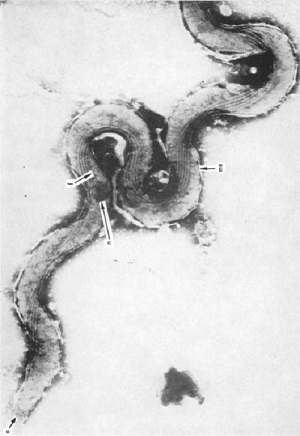Treponema pallidum - Introduction, Habitat, Morphology, Culture, Genome, History
Introduction to Treponema pallidum
Treponema pallidum is a thin, tightly coiled spirochaete bacterium, a member of the family Spirochaeticea. It is medically important as it causes congenital, sexually transmitted infection (STI) named Syphilis.[1]
Other pathogenic Treponema affecting humans includes-
Treponema pallidum subspecies pertenue causes yaws
Treponema carateum causes pinta
Treponema pallidum subspecies endemicum causes non-venereal (bejel) or endemic syphilis.[2]
History of Treponema pallidum
Historically, the origin of Syphilis is still debated and remains largely unknown. Two primary theories exist- referred to as the Columbian and pre-Columbian hypotheses. According to Columbian theory, human history dates Syphilis with the discovery of the New World by Christopher Columbus in 1492, and the disease was bought back from the new world to Europe by members of the crew. The pre-Columbian theory, on the other hand, states that syphilis existed in Europe but had remained unrecognized. [3]
In 1905, its causative organism Treponema pallidum was identified by Fritz Schaudinn and Erich Hoffmann.[4]
Epidemiology of Treponema pallidum
epidemiologically, Treponema pallidum is cosmopolitan in distribution for venereal syphilis but predominates in underdeveloped countries- incidence of yaws is high in the tropics, pinta is widespread in Central and South America, and in certain regions of the Middle East, endemic syphilis is present[1]
humans are the only reservoir i.e. are the only natural host[1]
it resides in the genital areas/tract of infected males and females with the infective rate highest in most sexually active age groups- 20-to 24, 15- to 19, 25- to 29 in descending order[1]
In the skin, found in the dermal-epidermal junction zone or throughout the dermis[5]
may be transmitted congenitally (placenta), through contact with an active lesion, or infected blood transfusion, but is mostly transmitted by sexual contact with infected lesions.[6]

Image: ultra-thin segments of T. pallidum viewed by electron microscope (Delektorskij, V. V.;Ovčinnikov N. M., 1966)
Morphology of Treponema pallidum
morphologically, Treponema pallidum is a gram-negative spirochaete, containing 6-12 uniform coils about 6-12μm in length and 01.-0.2μm in diameter [1]
actively motile with the help of flagella which are long, helical appendages enclosed in the periplasm[7]
presence of external envelope, a cytoplasmic-membrane, cytoplasmic substance, and a bundle of fibrils [8]
The outer membrane, which is measured at 70A°to 90A°, contains an outer electron-dense and an inner less dense sheet. The fibrils are situated between the external envelope and cytoplasmic membrane. Tensions of the fibrillar bundle determine the morphology of the spiral treponeme [8]
consists of individual segments whose size depends on the age of the culture
In young cultures, the segments are elongated and helical while in old cultures or in unfavorable conditions, there are short segments where some are rounded indicating cysts and cyst-like form.
Under favorable conditions, elongated form dominates, and in unfavorable conditions rounded form dominates i.e. cyst proper-like form.[9]
Composition of Treponema pallidum
The dry weight composition of Treponema pallidum includes approximately 70% proteins, 5% carbohydrates, and 20% lipid, which is relatively high. The complex lipid composition consists of several phospholipids, including cardiolipin and glycolipids, which is poorly characterized and is distinctive from lipopolysaccharide in terms of biochemical composition and immunological response.[1]
Cultural characteristics of Treponema pallidum [10]
Treponema pallidum is microaerophilic
unlike other microorganisms, they do not grow in artificial culture media or tissue culture. They have, however, been maintained for a long time by subculture in laboratory animals.
strains of Treponema pallidum can be and have been maintained for a short period of time in cell lines including Eagle and McCoy cell lines which have been supplemented with fetal bovine serum as well as a reducing agent.
These spirochaetes can be stored in a medium containing 5% glycerol at 70°C (158°F) or liquid nitrogen at -130°C (-202°F) for 10 to 15 years.
related to other human pathogens such as Borrelia and Leptospira.
Genome of Treponema pallidum
Fraser CM, et al. (1998) reported the complete sequence of Treponema pallidum. It showed 1,138,006 base pairs with 1041ORF (Open Reading Frame). [11]
Reference
- Radolf JD - Medical Microbiology
- Centurion-Lara A, J Molini B, et al. - Molecular Differentiation of Treponema pallidum Subspecies
- Farhi D, Dupin N - Origins of syphilis and management in the immunocompetent patient: facts and controversies
- C Franzen - Syphilis in composers and musicians--Mozart, Beethoven, Paganini, Schubert, Schumann, Smetana
- H J Engelkens, F J ten Kate, J Judanarso - The localisation of treponemes and characterisation of the inflammatory infiltrate in skin biopsies from patients with primary or secondary syphilis, or early infectious yaws
- Mandell GL, Bennett JE, Dolin R. - Principles and Practice of Infectious Diseases
- Wolgemuth CW - Flagellar motility of the pathogenic spirochetes
- Ryter A, Pillot J - Electron microscope study of the external and internal structure of the Reiter treponema
- Delektorskij, V. V.;Ovčinnikov N. M. - Morphology of Treponema pallidum
- Edmondson DG, Hu B, Norris SJ - Long-Term In Vitro Culture of the Syphilis Spirochete Treponema pallidum subsp. pallidum
- Fraser CM, et al. - Complete genome sequence of Treponema pallidum, the syphilis spirochete